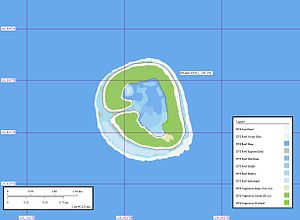Pinaki
| Pinaki | ||
|---|---|---|
| NASA image of Pinaki | ||
| Waters | Pacific Ocean | |
| archipelago | Tuamotu Archipelago | |
| Geographical location | 19 ° 23 ′ S , 138 ° 40 ′ W | |
|
|
||
| Number of islands | 1 | |
| Main island | Pinaki | |
| Land area | 1.3 km² | |
| Lagoon area | 70 ha | |
| Residents | uninhabited | |
| Map of Pinaki | ||
Pinaki , formerly called Whitsunday Island , is a small South Pacific atoll in the central eastern group of the Tuamotu Archipelago of French Polynesia . It is located about 10 km southeast of Nukutavake Island .
The area of the uninhabited atoll is less than 1.3 km². A single island surrounds the approximately 0.7 km³ large lagoon , the only connection between the lagoon and the ocean is in the west.
Pinaki was probably discovered in the spring of 1767 by the English naval officer Samuel Wallis and was once called Whitsunday Island . In 1859 a valuable treasure stolen from the church of Pisco is said to have been buried on the island.
Together with its neighboring island of Nukutavake, the upscale atoll Akiaki and two other atolls ( Vahitahi and Vairaatea ), Pinaki today forms the French-Polynesian community of Nukutavake , and belongs to the commune associée Nukutavake of the same name .
There are a few houses, a church and artificial cisterns in the northwest of the island, but these are only occasionally used by the residents of Nukutavake to extract copra and mother-of-pearl . The name of this only temporarily inhabited place is Pahakiri .
See also
Individual evidence
- ^ The Church Treasure of Pisco. Tuamotu Archipelago, French Polynesia. ( Memento of the original from 23 August 2012 in the Internet Archive ) Info: The archive link was automatically inserted and not yet checked. Please check the original and archive link according to the instructions and then remove this notice. David Hatcher Childress: Lost Cities of Lemuria & Pacific. Adventures Unlimited Press, 1988, ISBN 0932813046 , p. 270.
Web links
- Pictures of Pinaki (including photos of an expedition by zoologist Charles Haskins Townsend from 1900.)


